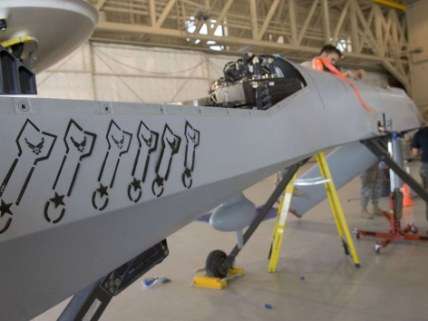The Future of War Under President Donald Trump Looks Like a Swarm of Drones
Reports show possible loosening of restrictions on strikes, more CIA participation.

Not long after Donald Trump was elected president I asked—in a headline, no less—"President Trump + Military Drones = What Exactly?" It was a question I didn't feel entirely confident answering back then because—for all his campaign talk about reducing our military footprint overseas while focusing on defeating the Islamic State—he didn't have much to say about using drones.
Looks like we're getting our answer: possibly more drone strikes, and possibly even less transparency about them than under President Barack Obama (which is pretty hard to imagine, given during most of his administration the government refused to discuss them). Stories in both The Washington Post and The Wall Street Journal show the machinery in action to spread the use of drone strikes as part of the Trump administration's efforts to fight terrorism.
According to The Washington Post, the administration is working to change the rules Obama put into place that would most certainly result in a greater number of drone strikes, and also a greater likelihood of civilian casualties:
The Trump review must still be approved by the president, but recent drafts of the new policy would represent a major change in the way the United States approaches drone strikes and other targeted-killing operations in places such as Yemen, Somalia and Libya.
The changes to the Obama-era Presidential Policy Guidance would empower the Pentagon to make decisions on targets without approval from the White House and potentially scrap the "near-certainty" standard of no civilian deaths for strikes outside war zones. The Trump plans are also likely to relax the requirement that potential terror targets pose a "continuing and imminent threat" to U.S. personnel, officials said.
A senior administration official said that the Trump White House remained committed to a standard above the minimum requirement mandated by the international law of armed conflict that governs most military operations.
"Some standard above [that] is wise," the official said.
As always, whenever policy proposals get leaked out before Trump actually approves them, be wary that we don't actually know yet whether it's really going to be implemented. What's very clear from the Post is that these unnamed sources they're using seem to want this decentralization to happen and allow military officials to decide more frequently on their own when to use drones to kill.
Like the proposal or not (you should not like it), it seems primed to be something Trump would support. As I noted back in November, an expansion of the use of drones seemed like a logical outcome given Trump's stated desires to focus on killing ISIS terrorists but not necessarily expand direct military engagement with troops on the ground.
The Wall Street Journal's reporting suggests not only will we have more drone strikes, but we might hear even less about them than we already do. That's because the Trump administration has authorized the CIA to perform its own strikes. Previously, while the CIA and the military worked together to gather intel for the strikes, the Obama administration's rules required the military perform the strikes. This, according to The Wall Street Journal, promoted "transparency and accountability" (reasonable people may disagree there). But because the CIA operates covertly, we may be less likely to know about the strikes they perform. And we already have an example. The CIA performed a drone strike against a target in Syria in February, but we're only finding out now that this operation was performed by the CIA under these new authorities:
While U.S. officials said Mr. Trump's action specifically applied to the CIA's ability to operate in Syria, it means the agency eventually could become empowered under Mr. Trump to once again conduct covert strikes in other places where the U.S. is targeting militants in Yemen, Libya, Somalia and elsewhere.
Syria may not be the only place where the CIA is now authorized to conduct drone strikes. Earlier this month, a U.S. drone reportedly targeted two men in a village in Pakistan near the border with Afghanistan. The Defense Department didn't acknowledge conducting the operation, as it typically would.
Whether the CIA's new authority might expand remains unclear. The CIA, the Pentagon and the White House are negotiating a longer-term approach to conducting counterterrorism operations and determining who has the authority to do what, U.S. officials said.
Ultimately, this highlights both the absurdity and the dangers of the executive branch writing its own rules on when to use these drone strikes without participation from Congress or a new Authorization of Use of Military Force focusing on the conflict as it exists now, not just how the world looked immediately post-Sept. 11. It's a bit mystifying that the Obama administration thought it could change the "rules" for extrajudicial drone assassinations and think that they'd survive a change in leadership.



Show Comments (18)